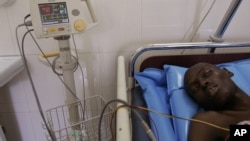DAKAR – The global public health community has praised Senegal for its early and effective response to HIV/AIDS since the country reported its first cases in 1986. For the past 15 years, infection rates have remained, on average, below one percent.
In 1985, two Senegalese doctors went to see their country's president, Abdou Diouf.
HIV/AIDS had only been discovered a few years earlier, and the two men had just documented an alarming 12-percent rate of infection among sex workers in Senegal, where prostitution is legal and regulated.
Countries With Highest Percentage of 15 to 49-Year-Olds Living With HIV/AIDS
Countries with Highest Percentage of 15 to 49-year-olds living with HIV/AIDS:1. Swaziland 25.9%
2. Botswana 24.8%
3. Lesotho 23.6%
4. South Africa 17.8%
5. Zimbabwe 14.3%
6. Zambia 13.5%
7. Namibia 13.1%
8. Mozambique 11.5%
9. Malawi 11.0%
10. Uganda 6.5%
Source: CIA World Factbook, 2009 estimates
They were Professor Souleymane Mboup, who would become world-renowned for his research on the HIV-2 strain of AIDS which is common in Africa, and Dr. Ibra Ndoye, the physician who would go on to head the National Council Against AIDS and devote his life to fighting the disease.
Dr. Ndoye says they presented their findings to President Diouf, who listened and then replied: "You are the experts. We trust you and we are behind you. Tell us what we need to do and we will do it." Dr. Ndoye says this support was nothing short of exceptional, as it would be at least a decade before many African leaders emerged from their denial about the disease and its impact.
That meeting marked the beginning of what has been praised as one of the most effective HIV-prevention campaigns on the planet.
Global AIDS Figures
Global AIDS Figures-
People Living with HIV
Adults - 30.1 million
Children - 3.4 million
- People newly infected with HIV in 2010 - 2.7 million
- AIDS deaths in 2010 - 1.8 million
Source: WHO
In 1986, Senegal was one of the first African countries to create a National Council Against AIDS to coordinate its efforts. The council's first order of business was to protect the nation's blood supply by putting in place systematic screening of donated blood and to train health workers about the disease.
Very early on, government officials appreciated the importance of getting access to anti-retroviral drugs. Senegal was one of the first African countries to negotiate hefty price cuts from multi-national pharmaceutical countries and to promote the use of ARVs among infected patients.
Since 1997, Senegal's HIV/AIDS prevalence rate has been below one percent, even as infection rates in other African countries skyrocketed to 15, even 25, percent.
Dr. Ndoye says Senegal saw early on that HIV was a very complex, even diabolical, virus. He says they realized a vaccine was a long way off, so they focused on prevention. He says they had the support of the government but they also enlisted civil society and religious leaders. Senegal is a very religious, majority-Muslim country, he says, and it was key to involve the religious leaders so they would not fight against the use of condoms.
Dr. Ndoye notes from the beginning, Senegal adopted what is now known as the ABC strategy: Abstinence, Be Faithful, Use a Condom. Though religious leaders have opposed condoms, some imams now make an exception for HIV-positive people who have relations with their spouses.
Senegal also became one of the first countries to integrate instruction about how to avoid contracting HIV in its secondary school curriculum. The United Nations says cultural norms in Senegal also discourage premarital and extramarital sex.
Despite Senegal's low national average, rates of infection remain elevated among high-risk communities. UNAIDS, the United Nations Program on HIV/AIDS, says infection rates hover over around 20 percent for female sex workers and men who have sex with men. Homosexuality is illegal in Senegal and punishable by fines and jail time. Homophobia has undermined prevention and screening efforts among gay men.
Dr. Ndoye says Senegal, despite its successes, must remain vigilant.
He spoke with VOA by phone from southeastern Senegal in late June where he was wrapping up a tour of five regions that are reporting infection rates of more than one percent.
Dr. Ndoye says they are there to shake things up and remind the local population and regional AIDS councils that one percent is considered the threshold level of an epidemic. He says on a national level, they need to take the taboo out of subjects like prostitution and homosexuality to fight high rates of infection among those communities. He says they are trying to anticipate all routes of infection - including an emerging trend of intravenous drug use - that could spread the virus to the general population.
Among gold miners in the Tambacounda and Kedougou regions, for example, he says they have found infection rates of 1.3 percent. It's a red flag, as mining communities have been hotbeds of HIV transmission in other countries, like South Africa.
Dr. Ndoye says the epidemic must be attacked on all fronts and this is “no time to rest our heads on our past achievements."











